Bulletin – September 2010 Structural Change in the Australian Economy
- Download the article 223KB
Abstract
Over time, the structure of the Australian economy has gradually shifted away from agriculture and manufacturing towards services, with the mining industry growing in importance recently. Economic activity has also shifted towards the resource-rich states of Queensland and Western Australia. Changes in the structure of the economy have been driven by a range of factors including rising demand for services, the industrialisation of east Asia, economic reform and technical change. In recent years, the rate of structural change appears to have increased, driven by the rise in resource export prices and mining investment.
Introduction
This article discusses the key changes in the structure of the Australian economy, particularly over the past 50 years.[1] The economy has been transformed from one centred on the production of primary products to an urbanised economy mainly producing services. In recent years there has also been a resurgence of the mining industry, lifting the industry's share of investment, output and exports, and contributing to the rising share of the states of Queensland and Western Australia within the economy. Consistent with this, a number of measures suggest that the rate of structural change picked up in the late 2000s. The article also sets out some of the factors that have driven structural change over recent decades.
Trends in Industry Structure
In the 19th century, the Australian economy was oriented towards primary production, with only a small manufacturing industry. Agriculture accounted for around one-third of output, and the share of mining surged dramatically during the booms in the 1850s and late in the century.[2] Service industries were nonetheless also important, accounting for around half of all activity, with relatively strong demand for services generated as a result of the long distances between population centres (in the case of transportation and communications) and the relatively high income earned from agriculture and mining.[3]
The 20th century saw the rise of manufacturing followed by the expansion of service industries. By the 1950s, the manufacturing industry's share of total employment had risen to around 25 per cent, from 15 per cent at the turn of the century (Graph 1).
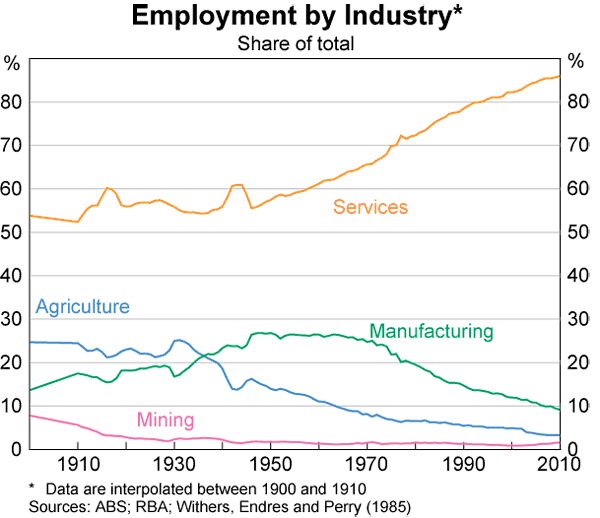
Since the 1960s, the share of manufacturing in the overall economy has declined, although in absolute terms manufacturing production has continued to expand.
Service industries have grown strongly over the past 50 years, rising from around 60 per cent of total output in the 1960s to around 80 per cent recently (Table 1). In the 1950s, services were closely linked to manufacturing, with wholesale trade and transport supporting the production and distribution of manufactured goods. Since then, the share of distribution services has steadily fallen, consistent with the declining relative importance of manufacturing and also agriculture. In contrast, the fastest growing service industries in recent years have been business services, including financial and professional services, and social services such as health and education (Graph 2).[4] Service industries are generally more labour intensive (and less capital intensive) than manufacturing, mining and agriculture, with services employing around 85 per cent of the workforce, but representing only around 70 per cent of investment.[5]
| Agriculture | Mining | Manufacturing | Services | |||
|---|---|---|---|---|---|---|
| Output(a) | ||||||
| – 1960s | 13 | 2 | 26 | 59 | ||
| – 1980s | 6 | 6 | 19 | 70 | ||
| – 2000s | 3 | 7 | 12 | 78 | ||
| Employment | ||||||
| – 1960s | 10 | 1 | 26 | 63 | ||
| – 1980s | 6 | 1 | 17 | 75 | ||
| – 2000s | 4 | 1 | 11 | 84 | ||
| Investment(b) | ||||||
| – 1960s | 11 | 5 | 19 | 64 | ||
| – 1980s | 6 | 11 | 13 | 70 | ||
| – 2000s | 4 | 13 | 11 | 72 | ||
| Exports | ||||||
| – 1960s | 62 | 15 | 9 | 14 | ||
| – 1980s | 33 | 38 | 10 | 18 | ||
| – 2000s | 18 | 42 | 17 | 23 | ||
|
(a) Nominal value added excluding ownership of dwellings Sources: ABS; RBA; Withers et al (1985) |
||||||
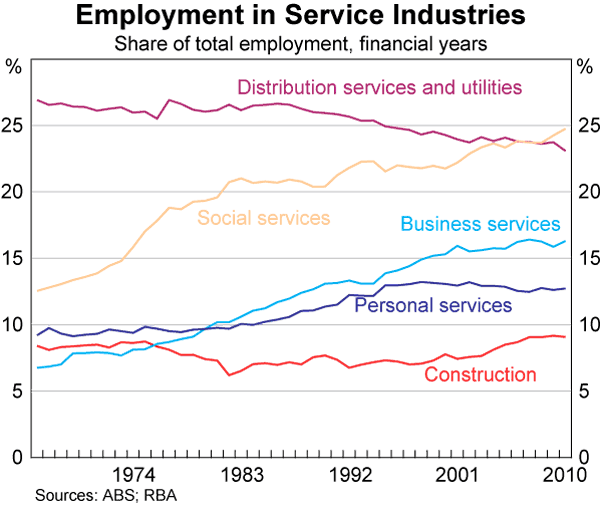
Over the past 50 years, the mining industry's share of nominal output has fluctuated considerably, but has trended higher to be around 8 per cent in 2009/10, up from 2 per cent in the 1960s (Graph 3). Investment in the mining industry has also risen from 5 per cent of total investment in the 1960s to around 19 per cent in 2009/10, well above the peaks in the previous mining booms in the early 1970s and the early 1980s. Notwithstanding this rise, the mining industry's share of employment has remained relatively small, reflecting its high capital intensity. The mining boom over recent years has also had effects on other industries. In particular, output and employment in the construction industry have grown solidly, reflecting strong demand for mining-related construction (Graph 2). There has also been a shift in the composition of the manufacturing industry towards mining-related manufacturing, and away from import-competing manufactures.
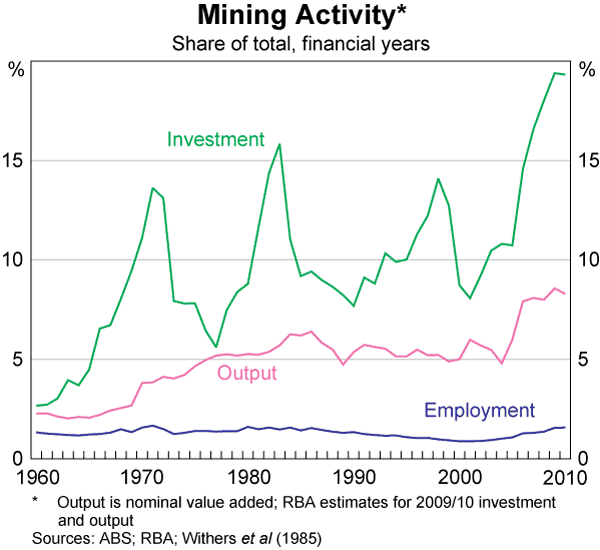
In contrast to output and employment, Australia's exports are still dominated by commodities (Graph 4). In 2009/10, mining exports accounted for around half of export income, while agricultural goods accounted for around 10 per cent of export income. Throughout the past two centuries, commodity exports have accounted for at least half of Australia's export income, reflecting a comparative advantage in the production of these goods. For almost of the 19th century, the single biggest export was wool, and until the 1950s, less than 10 per cent of export income was from manufactures. The shares of manufacturing and services exports each rose through the 1990s. These shares have declined in recent years, mainly due to the strength of commodity prices.

Trends in Activity by State
During the past 150 years, the Australian population and economic activity have spread from the south-eastern states towards Queensland and Western Australia in two broad waves – in the second half of the 19th century and in the past 50 years (Graph 5). Victoria's population share peaked with the gold rush in the 1850s, which attracted immigrants from other Australian colonies and overseas, and declined over the remainder of the 19th century as Queensland and New South Wales grew strongly. The 1890s depression hit Victoria particularly hard, encouraging further outflows of labour, with many migrating to Western Australia where another mining boom was under way.[6]
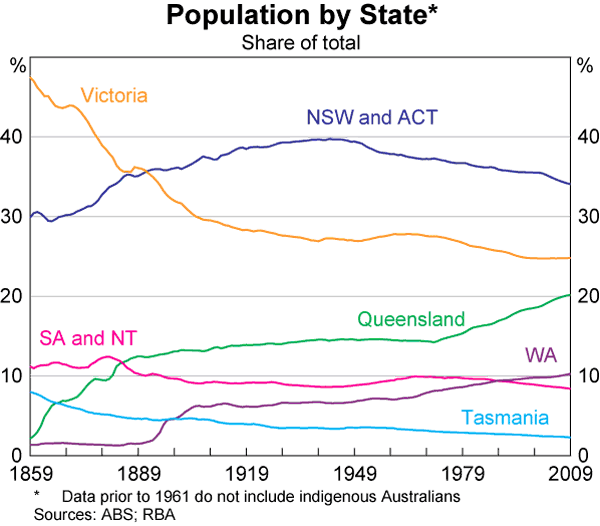
Over the past 50 years or so, Western Australia and Queensland have grown relatively strongly, with their share of output and employment rising steadily from around 20 per cent in the 1960s to more than 30 per cent recently (Graph 6, Table 2). The population has also grown strongly in these states, driven by immigrants and, in the case of Queensland, interstate migration from the south-eastern states. Strong population growth has contributed to faster output growth across nearly all industries in these states relative to the national average over the past two decades; growth in output per capita has been more evenly distributed across the country.[7] The mining booms in the late 1960s and the late 2000s also contributed to the rising share of the resource-rich states in the national economy, particularly in terms of investment. However, compared with the 19th century, the changes in regional population shares in recent decades have occurred fairly smoothly, with modern mining booms being much less labour intensive than their forerunners.
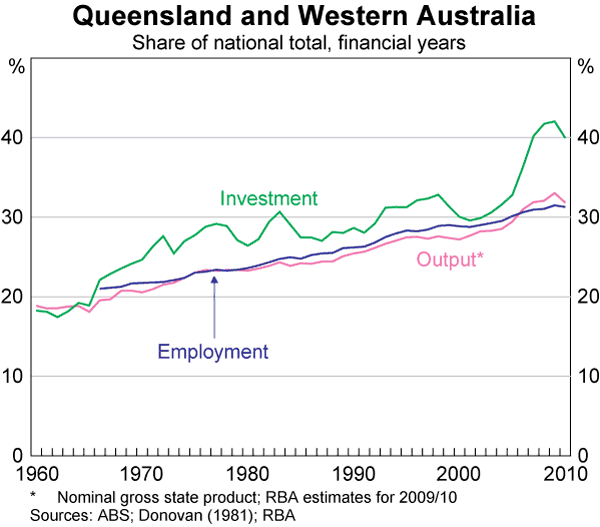
| NSW and ACT | Queensland | SA and NT | Tasmania | Victoria | WA | |
|---|---|---|---|---|---|---|
| Output(a) | ||||||
| – 1960s | 38 | 13 | 9 | 3 | 32 | 6 |
| – 1980s | 35 | 15 | 9 | 3 | 30 | 9 |
| – 2000s | 35 | 18 | 8 | 2 | 25 | 12 |
| Employment | ||||||
| – 1960s(b) | 38 | 14 | 10 | 3 | 28 | 8 |
| – 1980s | 36 | 16 | 10 | 3 | 27 | 9 |
| – 2000s | 35 | 20 | 8 | 2 | 25 | 10 |
| Investment | ||||||
| – 1960s | 39 | 13 | 9 | 4 | 28 | 7 |
| – 1980s | 36 | 18 | 9 | 2 | 24 | 10 |
| – 2000s | 32 | 21 | 8 | 2 | 24 | 14 |
|
(a) Nominal gross state product Sources: ABS; RBA; Withers et al (1985) |
||||||
The Rate of Structural Change
There is no universally accepted measure of the rate of structural change, but a commonly used approach, and the one adopted in this article, is to calculate structural change indices. In terms of industry structure, these indices measure the change over a specified period – in this case five years – in the share of the different industries in total nominal output, real output, employment or investment (Graph 7).[8] Similar indices are calculated to measure the change in economic activity over time across states. If there has been no change in the relative importance of different industries (or states) over the period, these indices will have a value of zero. If, for example, the share of one industry (or state) has increased by 2 percentage points (with a corresponding decrease in the other shares), then the index has a value of 2.
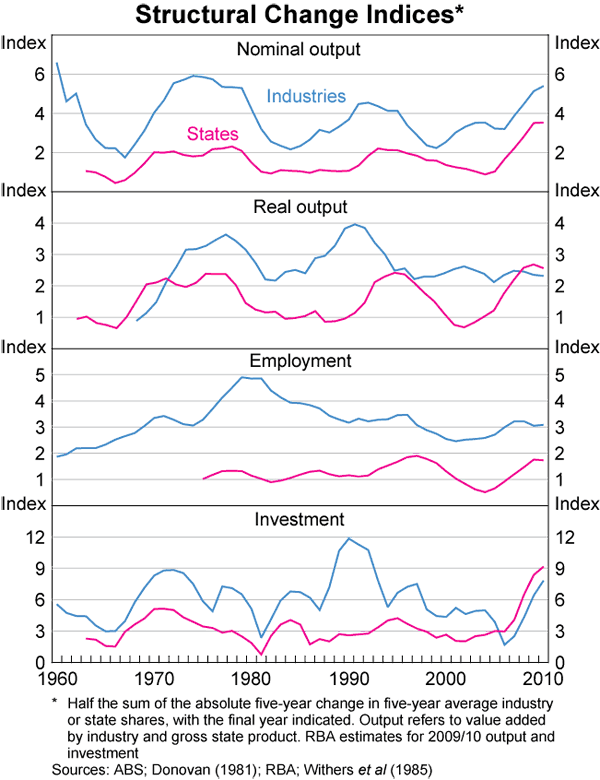
Using the various indices we can identify periods with high rates of structural change and periods of relative stability over the past 50 years. The indices suggest that structural change was high from the late 1960s through to the late 1970s, from the late 1980s through to the mid 1990s and also more recently. The earlier episodes commenced with investment booms – in mining in the late 1960s and in business services in the late 1980s – which flowed through to rising output shares in these industries over following years. At the same time, the shares of manufacturing and agriculture fell as resources were attracted to the booming industries. Another factor was a large increase in the share of social services in the 1970s. In the early 1990s, elevated rates of structural change by industry and state were associated with the recession, when there was a sharp contraction in manufacturing output and employment. This had a disproportionate effect on Victoria and South Australia, given their relatively large manufacturing industries. Compared with the periods of rapid structural change, the structure of the economy was relatively stable in the mid 1960s and the early 2000s, which were both periods of solid economic growth and price stability.
Across a range of measures, the rate of structural change appears to have increased in recent years, partly driven by the mining boom in Western Australia and Queensland. This is particularly noticeable in the measures using nominal output, reflecting the sharp rise in commodity prices over recent years. It is also evident in investment across the states, although by industry this measure remains well below the peak associated with the commercial property boom in the late 1980s. Structural change in real output and employment has not picked up to the same extent as for investment, reflecting the inevitable lags between investment and real output and the fact that the mining industry directly employs a relatively small share of the workforce. The rate of structural change across the states has been the highest since at least the mid 1960s on most measures, partly reflecting that the current mining boom is larger and more geographically concentrated than the previous booms in the late 1960s and the early 1980s. Nevertheless, the strong growth in Queensland and Western Australia has been quite broad based across industries.
Some Factors Driving Structural Change
A range of factors have driven structural changes in the Australian economy, including rising consumer demand for services, the industrialisation of east Asia, economic reform and technical change.
Rising demand for services
The increase in the share of services in the Australian economy largely reflects rising consumer demand for services as real incomes have increased. The share of consumption spent on services has risen from 40 per cent in 1960 to over 60 per cent currently, reflecting rising spending on health, education, recreational services and financial services. A similar trend in the share of services in output is evident in many other economies (Graph 8).[9]

The rising share of services in the economy has coincided with increasing labour force participation, and these trends are likely to be related for several reasons. The increase in the proportion of families where both parents work has generated more demand for services previously provided within the household (and therefore not measured in production), such as childcare, pre-school education, home maintenance and aged care. The demand for health services has also grown with increased longevity. At the same time, service industries have been the source of almost all of the growth in employment over the past two decades, and have facilitated the increase in labour force participation by providing jobs with more flexible working hours than in the traditional goods-producing industries.
Industrialisation of east Asia
The emergence of the economies of east Asia as major producers of manufactured goods over the past 50 years has also had a significant effect on the structure of the world economy. East Asia's share of global manufacturing more than doubled from 1970 to 2008, reflecting the region's comparative advantage owing to relatively low labour costs. This process was led by Japan from the 1960s, followed by the newly industrialising economies of east Asia, and most recently China (Graph 9). The rising share of manufacturing in east Asia has been mirrored by a decline in the share of the United States and Europe, as well as in Australia's share.

The strong growth in Asia's demand for commodities to supply an expanding manufacturing sector has significantly boosted the share of resources in Australian export income and the economy more generally, reflecting Australia's resource endowment and proximity to Asian markets. Other factors, including government policy and technology, have also played a role in the rise of the Australian mining industry. For instance, the development of the iron ore export industry in the 1960s followed the lifting of an embargo on iron ore exports and lower transportation costs flowing from the introduction of bulk carriers.
Economic reform
The economic reforms undertaken by Australian governments over recent decades to improve the efficiency of the economy have also driven structural change. These reforms include the restructuring and deregulation of a range of service industries and the reduction in the level of trade protection provided to goods-producing industries.
Policies designed to promote greater competition in a range of service industries have contributed to the increasing share of services in the economy.[10] In particular, the deregulation of the finance industry in the 1980s and the introduction of compulsory superannuation supported the growth of banking and funds management. The restructuring of a range of services previously provided by government monopolies also led to more competition in the utilities, communications and transport industries.
The reforms also include reductions in the protection provided to the manufacturing industry, which grew in the first half of the 20th century under the protection of trade barriers. From the early 1970s, these trade barriers were progressively wound back – Productivity Commission estimates indicate that the effective rate of assistance to manufacturing has fallen from around 35 per cent of output in the early 1970s to around 5 per cent in the 2000s (Graph 10). Agriculture historically received some support in the form of tax concessions and subsidies, particularly during periods of drought or low world rural commodity prices, and this support has also decreased over time. Lower trade barriers have given households and businesses access to imported goods for investment and consumption at reduced cost, allowing them to benefit from the comparative advantage of east Asia in the production of manufactures. In response to the increase in international competition, the manufacturing industry has become more productive and export-oriented.[11]

Technical change
The development and application of new technologies has also driven structural change over recent decades, particularly in service industries. Since 1970, investment in computers and software has increased exponentially in real terms, reflecting the rapid improvement in the quality of computers over time and their range of uses. In the finance industry, the adoption of technologies such as automatic teller machines and electronic payment methods in the 1980s and 1990s resulted in significant structural change. Improved transportation technologies and new business practices (such as just-in-time production) are also likely to have resulted in better inventory management and contributed to the reduction in the relative size of distribution services such as wholesale trade and transport.
Over recent decades, firms in goods-producing industries such as manufacturing have progressively outsourced a range of business services to take advantage of the economies of scale generated when these services are pooled together and provided by specialised firms. The outsourcing of services such as accounting, marketing and IT support is also likely to have been hastened by improvements in communications technology, together with increasing trade in services, which exposed service industries to greater competition. As such, the resulting rise in service industries' share of the economy may be overstated since it partly represents the measurement of activities previously undertaken by the goods-producing industries.[12]
Conclusion
The structure of the Australian economy has shifted over time away from agriculture and manufacturing towards services. Structural change has tended to occur in waves, driven by a range of factors including rising demand for services, the industrialisation of east Asia, economic reform and technical change. In recent years, the mining sector has also grown in importance, contributing to the expansion of the resource-rich states of Queensland and Western Australia relative to the south-eastern states. The mining boom has also led to an increase in the rate of structural change, particularly when measured in terms of nominal output and investment.
Footnotes
The authors are from Economic Analysis Department. [*]
The data used in this article are drawn from multiple sources and involve splicing series compiled under different industry classifications and systems of national accounts, which may affect the comparability of series over time. [1]
Battellino (2010a) discusses the five major mining booms in Australia's history. See Butlin (1985) for 19th century GDP estimates. [2]
See Maddock and McLean (1987). [3]
In this article we have aggregated the 19 industries in the ANZSIC 2006 classification into 8 industry groups, excluding ownership of dwellings: agriculture (agriculture, forestry & fishing); mining; manufacturing; construction; distribution services and utilities (electricity, gas, water & waste services, wholesale trade, retail trade, transport, postal & warehousing and information media & telecommunications); business services (financial & insurance, rental, hiring & real estate, professional, scientific & technical and administrative & support); social services (public administration & safety, education & training and health care & social assistance); and personal services (accommodation & food, arts & recreation and other). [4]
In this article, investment by industry includes business and public investment and excludes dwelling investment and cultivated biological resources. Investment by state includes business, public and dwelling investment and excludes cultivated biological resources. [5]
See Blainey (1963, p 195). [6]
For more details, see Battellino (2010b). [7]
The structural change index (SCI) takes the form:

where xi,t is the average share of industry (or state)
i in the economy in the five years to year t; we use five-year
averages to abstract from short-term variation in the composition of the
economy. For a more detailed description, see Productivity Commission (1998).
The eight industry groups used are: agriculture; mining; manufacturing; construction;
distribution services and utilities; business services; social services;
and personal services. In the state measure, the Australian Capital Territory
is included with New South Wales and the Northern Territory is included with
South Australia. Note that real output shares are sensitive to the choice
of base year.
[8]
This trend was highlighted as one of the key characteristics of modern economic growth in Kuznets (1973). [9]
For more details on these reforms, see Forsyth (2000). [10]
See Dwyer and Fabo (2001) and Productivity Commission (2003). [11]
See Productivity Commission (2003) for a discussion of inventory management and outsourcing by manufacturing firms. [12]
References
Battellino R (2010a), ‘Mining Booms and the Australian Economy’, RBA Bulletin, March, pp 63–69.
Battellino R (2010b), ‘Twenty Years of Economic Growth’, RBA Bulletin, September, pp 103–111.
Blainey G (1963), The Rush that Never Ended, Melbourne University Press, Melbourne.
Butlin NG (1985), ‘Australian National Accounts: 1788–1983’, Australian National University Source Papers in Economic History No 6.
Donovan JB (1981), ‘Social Accounting Measures of Regional Growth’, in RL Matthews (ed), Regional Disparities and Economic Development, Australian National University, Canberra, pp 221–254.
Dwyer J and J Fabo (2001), ‘The Manufacturing Sector: Adapting to Structural Change’, RBA Bulletin, March, pp 1–9.
Forsyth P (2000), ‘Microeconomic Policies and Structural Change’, in D Gruen and S Shrestha (eds), The Australian Economy in the 1990s, Proceedings of a Conference, Reserve Bank of Australia, Sydney, pp 235–267.
Kuznets S (1973), ‘Modern Economic Growth: Findings and Reflections’, The American Economic Review, 63(3), pp 247–258.
Maddock R and IW McLean (1987), ‘The Australian Economy in the Very Long Run’,
in R Maddock and
IW McLean (eds), The Australian Economy in the Long Run, Cambridge
University Press, Melbourne,
pp 5–29.
Productivity Commission (1998), Aspects of Structural Change in Australia, Research Paper, AusInfo, Canberra.
Productivity Commission (2003), Trends in Australian Manufacturing, Commission Research Paper, AusInfo, Canberra.
Timmer MP and GJ de Vries (2007), ‘A Cross-country Database for Sectoral Employment and Productivity in Asia and Latin America, 1950–2005’, University of Groningen, Groningen Growth and Development Centre Research Memorandum GD-98, August.
Withers G, T Endres, and L Perry (1985), ‘Australian Historical Statistics: Labour Statistics’, Australian National University Source Papers in Economic History No 7.